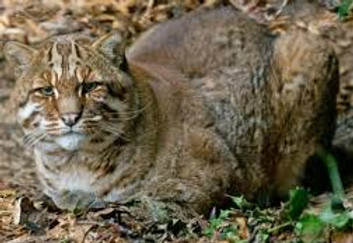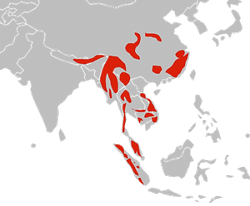Asian Golden Cat(Catopuma temminckii)
They are known as Temminck's cat and Asiatic golden cat and known as the fire cat in Thailand and Burma, and as the rock cat in parts of China, are of a medium size and stocky build. They form the second largest category of Asiatic felines. Their fur ranges in color from cinnamon to various shades of brown, and also gray and black (melanistic). There are some cats with spotted and striped markings, in appearance similar to an ocelot. Sometimes there are stripes on the cat’s head and cheeks as well.

Their ears are black on the outsides and gray on the insides. The cat’s underside is usually white. The Asian golden cat is a medium-sized cat with a head-to-body length of 66–105 cm, with a 40–57 cm long tail, and is 56 cm tall at the shoulder. In weight, it ranges from 9-16 kg, which is about two or three times that of a domestic cat
Habitat
The Asian golden cat occurs in Southeast Asia, from Nepal and Tibet to Southern China, Sumatra and India. It prefers forest habitats that are interspersed with rocky areas, being found in deciduous, tropical and subtropical evergreen rainforests. It sometimes lives in more open terrain like the grasslands of Assam's Manas National Park.

Diet
Asian golden cats are carnivores, often eating small prey like Indochinese ground squirrel, small snakes and other reptiles, muntjacs, rodents, birds, and young hares. In Sikkim, India, in the goral mountains, they also hunt larger animals like wild pig, water buffalo calves and sambar deer. Where humans are present, they will also prey on domesticated sheep, goats, and poultry.
Breeding
Little is known about this cat’s reproductive behaviour in the wild, and most of what we know is due to observing cats in captivity. Asian golden cats are polygynous, which means that one male gets exclusive mating rights with multiple females. There appears to be no breeding season for the Asian golden cat, but from April to June no births occur. After gestation of about 81 days, 1 to 3 kittens are born. Kittens are weaned when they are 6 months old and they reach independence as early as 9 months, the average being 12 months. Female Asian golden cats reach sexual maturity between 18 and 24 months, males maturing at 24 months.
Population
According to the IUCN Red List, they are classed Near Threatened(NT). A lack of density estimates across the range makes it difficult to accurately assess the true population status of the species. Owing to somewhat similar camera trap encounter rates, the Asiatic Golden Cat is thought to have comparable abundances to those of sympatric felids. However, some surveys have recorded the Golden Cat more frequently than sympatric felid species, while others have recorded the it less frequently, so their relative abundance likely varies significantly across their range. In addition, it is important to consider that the Asiatic Golden Cat is thought to be mainly terrestrial, which may influence the number of camera trap photos recorded. Their current population trend is decreasing.
Threats
As a forest dependent species, the Asiatic Golden Cat is threatened by habitat loss throughout it's range. Although deforestation rates in Southeast Asia have slowed substantially, they are still among the highest in the world. An increasing number of hydropower projects in countries such as Bhutan, also have the potential to negatively impact the species. In addition, the species is threatened by increasing levels of illegal hunting and poaching for consumption, and for the sale of pelts and body parts. There is thought to be some level of poaching or hunting of the species in every country across its range. Pelts have been recorded being traded along the Myanmar-Thailand border, and in Sumatra, and skins are reported from several sites in northeast India. Poaching pressure is particularly high in China and Viet Nam, where the species may soon face extirpation. In Viet Nam, there is some evidence that the species is increasingly targeted as a substitute for Tiger skins and parts, as Tigers become more difficult to obtain. There have been several incidences of confiscated Golden Cat pelts which were painted to resemble that of a Tiger. Snaring appears to be on the rise across much of mainland Southeast Asia, and constitutes a major threat to the species. In Bangladesh, several recent specimens indicate that the species is commonly hunted by indigenous peoples in the Chittagong Hill Tracts. Conflict with humans due to livestock depredation is also thought to be an issue for the species. Retribution killing of the species in response to chicken depredation was recorded in Sumatra.
Conservation
The Asiatic Golden Cat is listed under Appendix I of CITES, and is officially protected over most of its range by national legislation. Legal hunting is prohibited in Bangladesh, Cambodia, China, India, Indonesia, Peninsular Malaysia, Myanmar, Nepal, Thailand and Viet Nam, and is regulated in Lao PDR. However, there are indications of increasing illegal hunting and poaching in many range countries. Research on the ecology of this species is essential in order to understand population trends and implement effective conservation strategies.